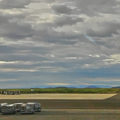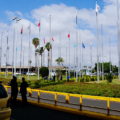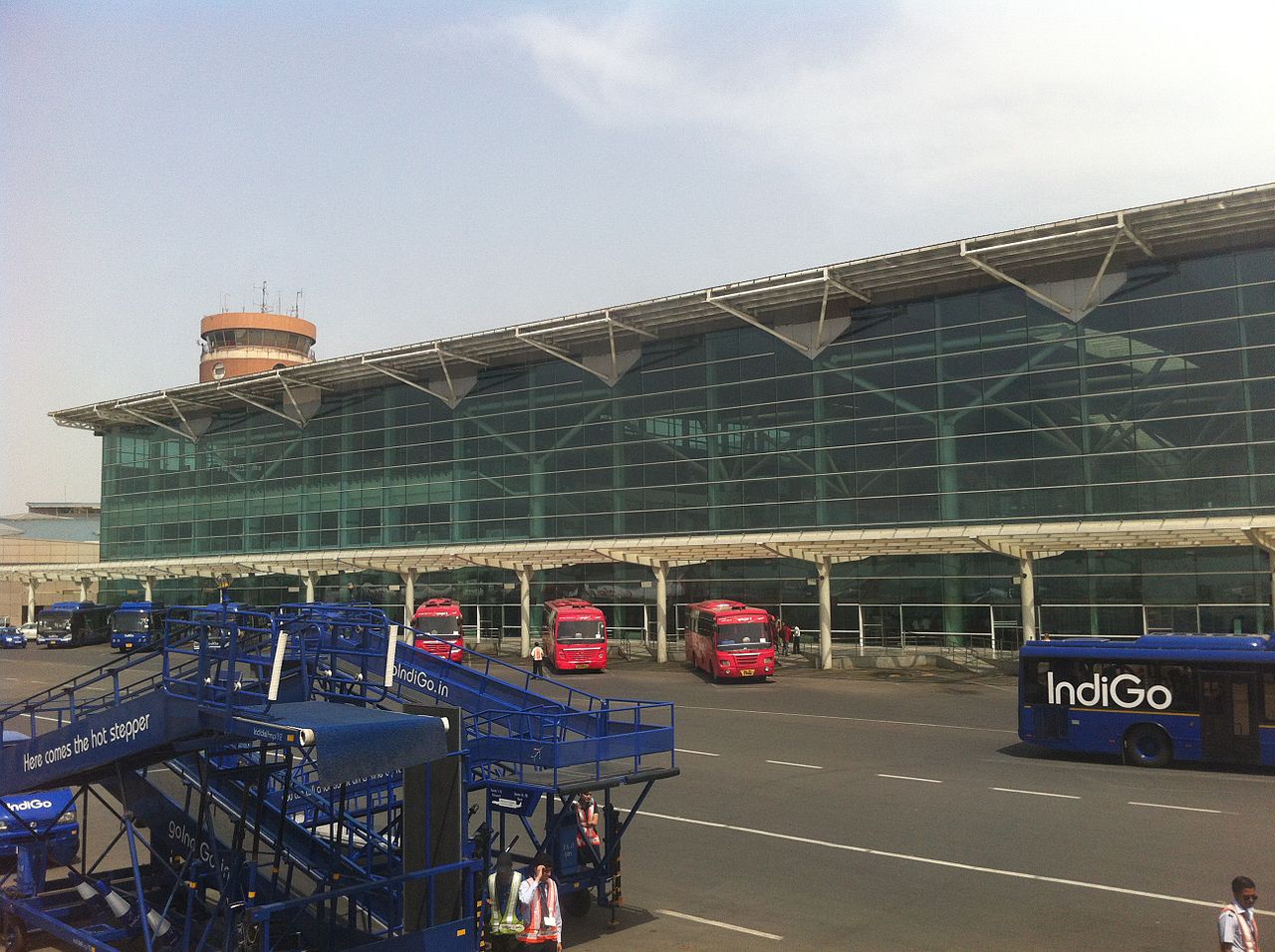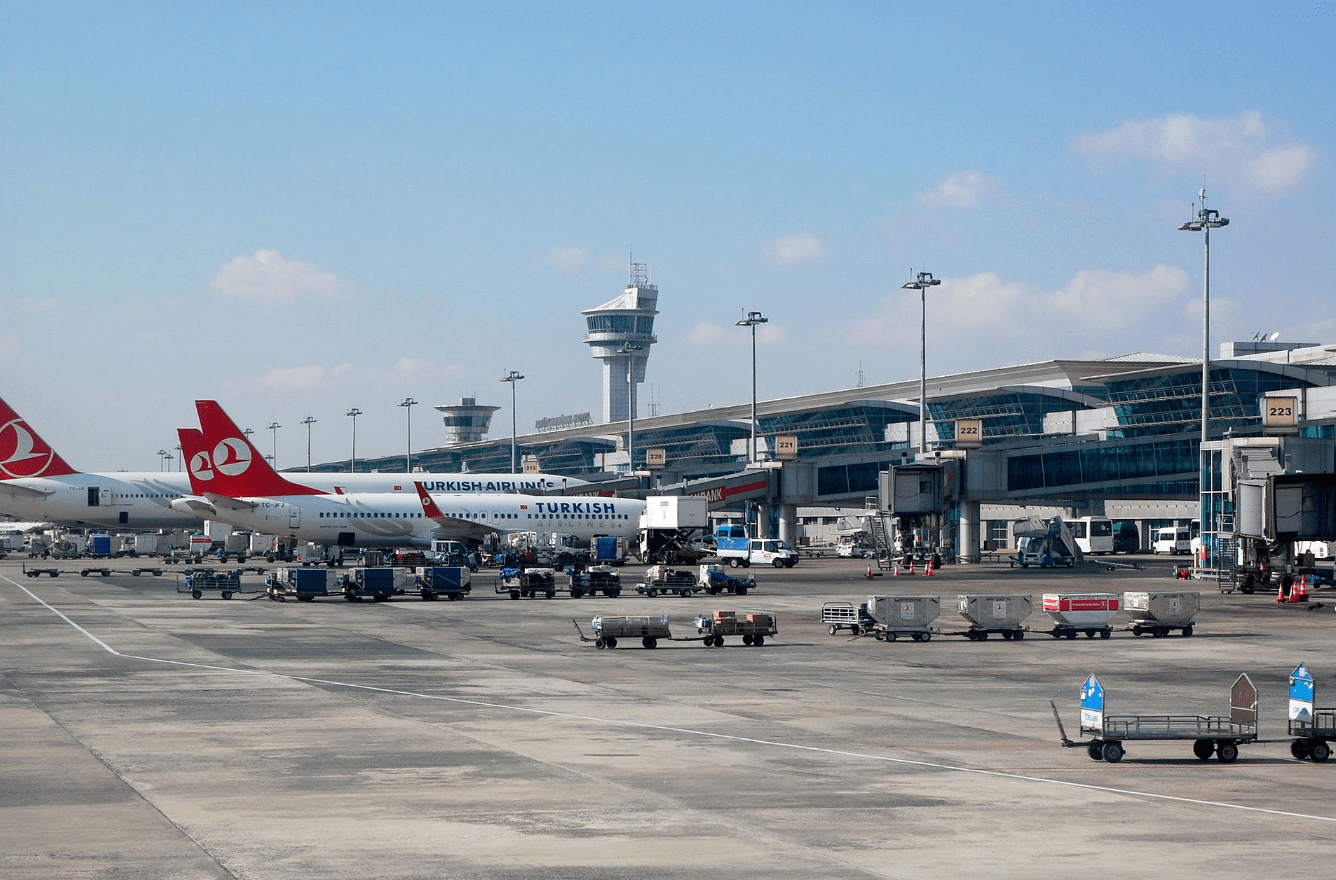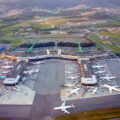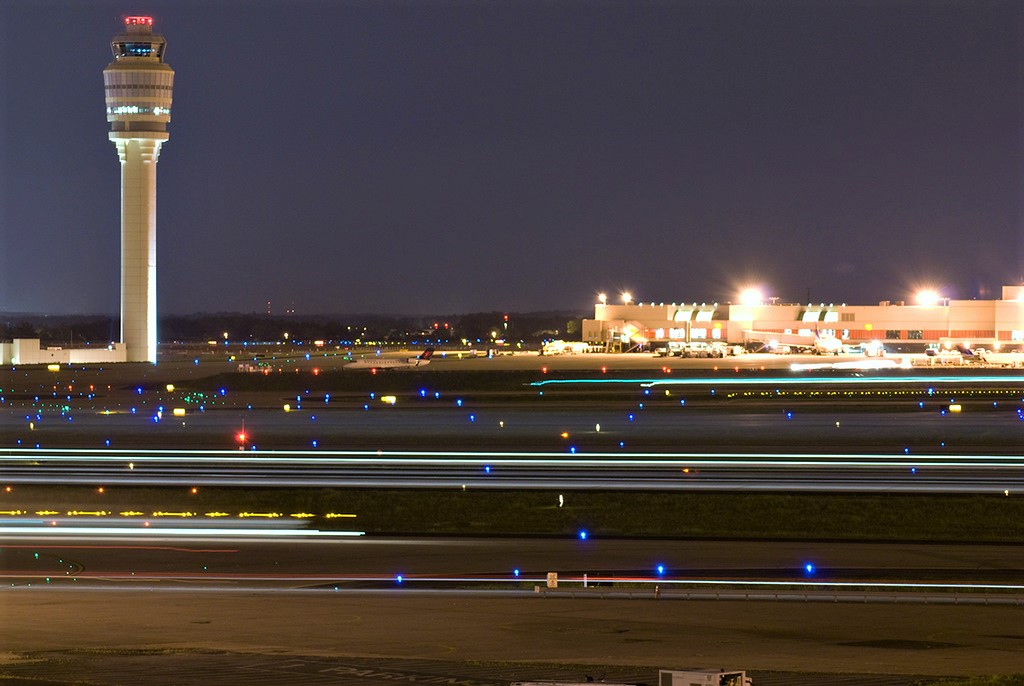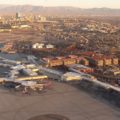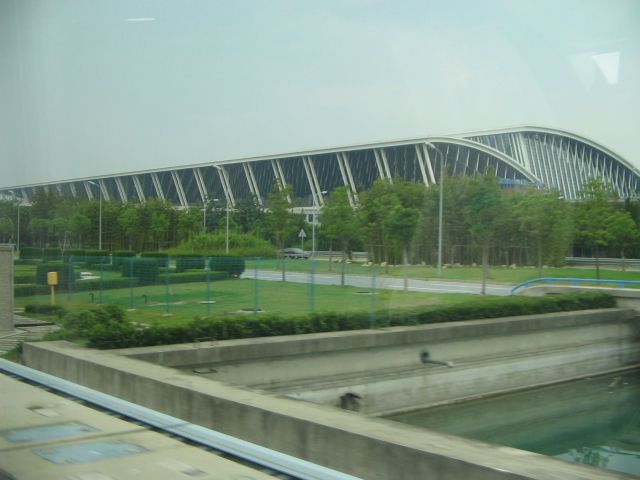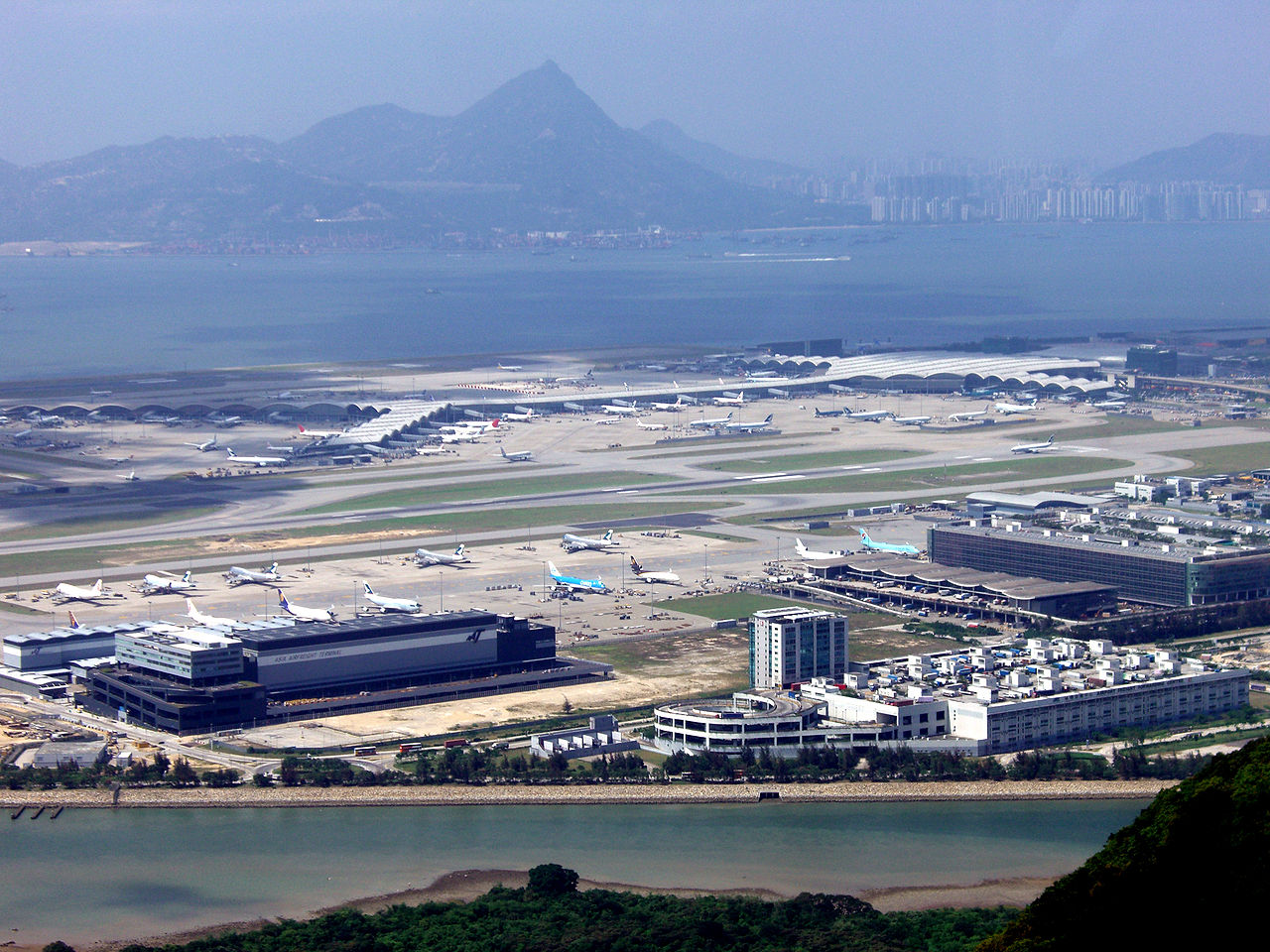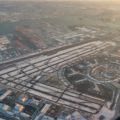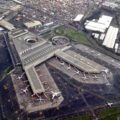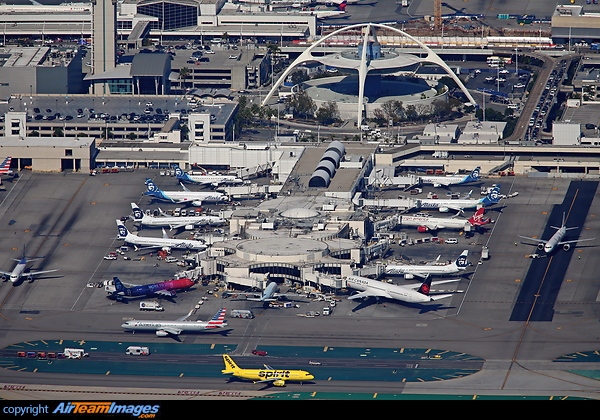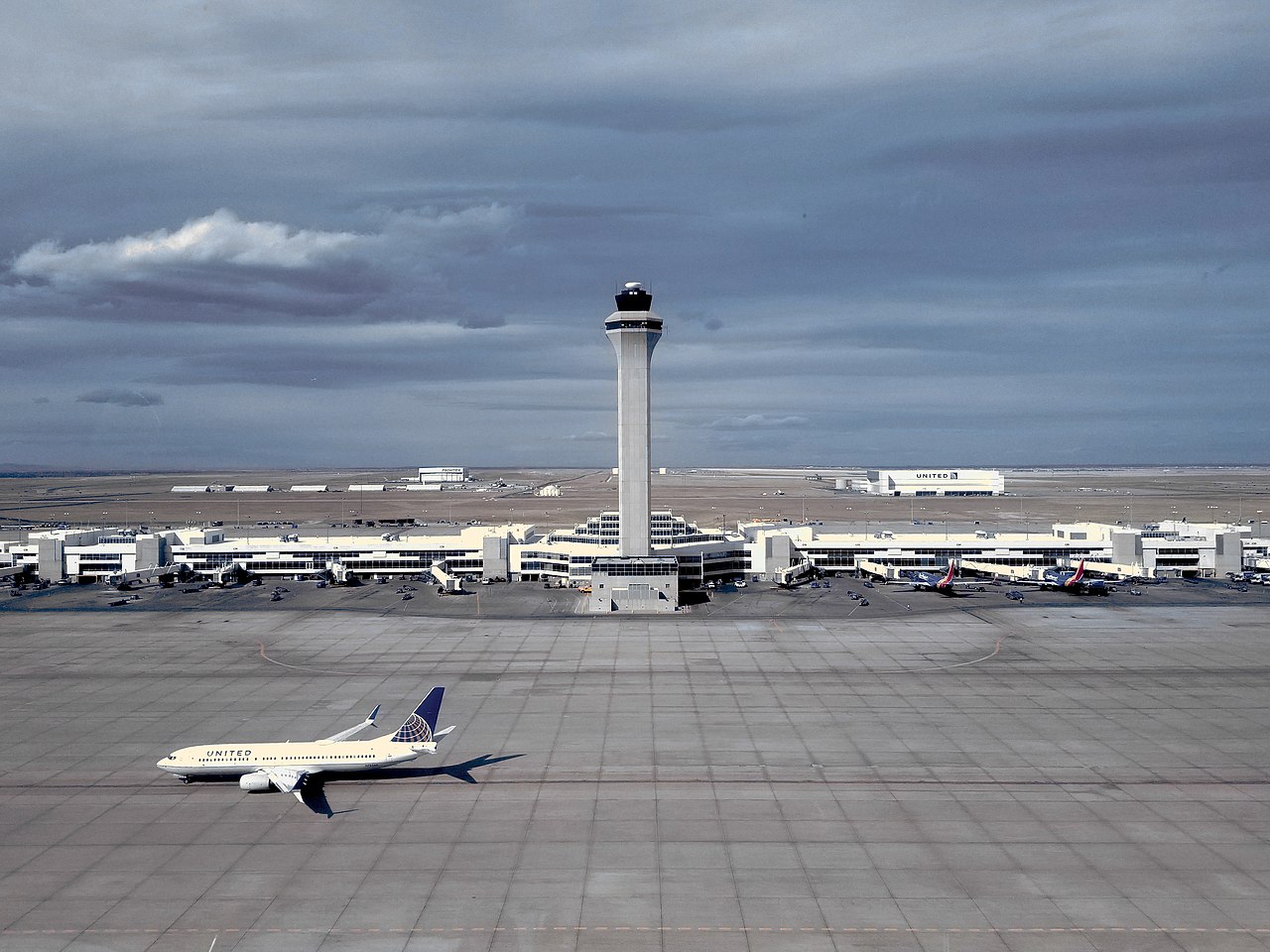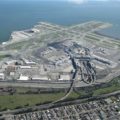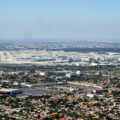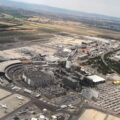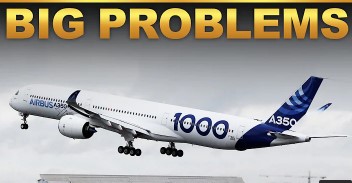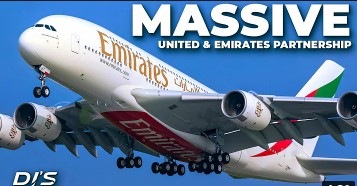Dubai International Airport
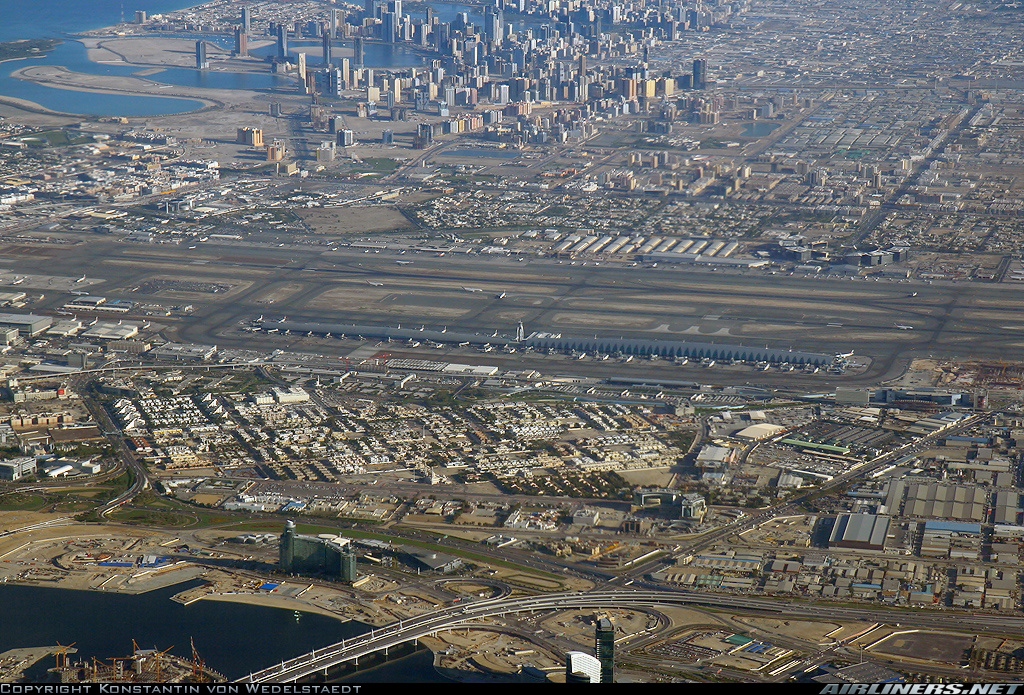
Source: AIRLINERS.NET
| IATA: DXB ICAO: OMDB WMO: 41194 | |
| Airport type | Public |
| Owner | Government of Dubai |
| Operator | Dubai Airports Company |
| Serves | Dubai, United Arab Emirates |
| Hub for | EmiratesflydubaiFedEx Express |
| Elevation AMSL | 62 ft / 19 m |
| Coordinates |  25°15′10″N 055°21′52″ECoordinates: 25°15′10″N 055°21′52″ECoordinates:  25°15′10″N 055°21′52″E 25°15′10″N 055°21′52″E |
| Website | dubaiairports.ae |
Dubai International Airport (IATA: DXB, ICAO: OMDB) (Arabic: مطار دبي الدولي) is the primary international airport serving Dubai, United Arab Emirates, and is the world’s busiest airport by international passenger traffic. It is also the fifth-busiest airport in the world by passenger traffic, the sixth-busiest cargo airport in the world, the busiest airport for Airbus A380 and Boeing 777 movements, and the airport with the highest average number of passengers per flight. In 2017, DXB handled 88 million passengers and 2.65 million tonnes of cargo and registered 409,493 aircraft movements. In July 2019, Dubai International airport installed the largest solar energy system in the region’s airports as part of Dubai’s goal to reduce 30 percent of the city energy consumption by 2030.
Dubai International Airport is situated in the Al Garhoud district, 2.5 nautical miles (4.6 km; 2.9 mi) east of Dubai and spread over an area of 7,200 acres (2,900 ha) of land. Terminal 3 is the second-largest building in the world by floor space and the largest airport terminal in the world.
Emirates Airline has its hub airport in Dubai International (DXB) and has their own terminal 3 with 3 concourses that they share with flydubai. The Emirates hub is the largest airline hub in the Middle East; Emirates handles 51% of all passenger traffic and accounts for approximately 42% of all aircraft movements at the airport. Dubai Airport is also the base for low-cost carrier flydubai which handles 13% of passenger traffic and 25% of aircraft movements at DXB. The airport has a total capacity of 90 million passengers annually. As of January 2016, there are over 7,700 weekly flights operated by 140 airlines to over 270 destinations across all inhabited continents. Over 63% of travelers using the airport in 2018 were connecting passengers.
Dubai International is an important contributor to the Dubai economy, as it employs approximately 90,000 people, indirectly supports over 400,000 jobs and contributes over US$26.7 billion to the economy, which represents around 27 per cent of Dubai’s GDP and 21% of the employment in Dubai. It is predicted that by 2020, the economic contribution of Dubai’s aviation sector will rise to 37.5% of the city’s GDP and by 2030, the economic impact of aviation is projected to grow to $88.1 billion and support 1.95 million jobs in Dubai or 44.7% of the GDP and 35.1% of the total employment.
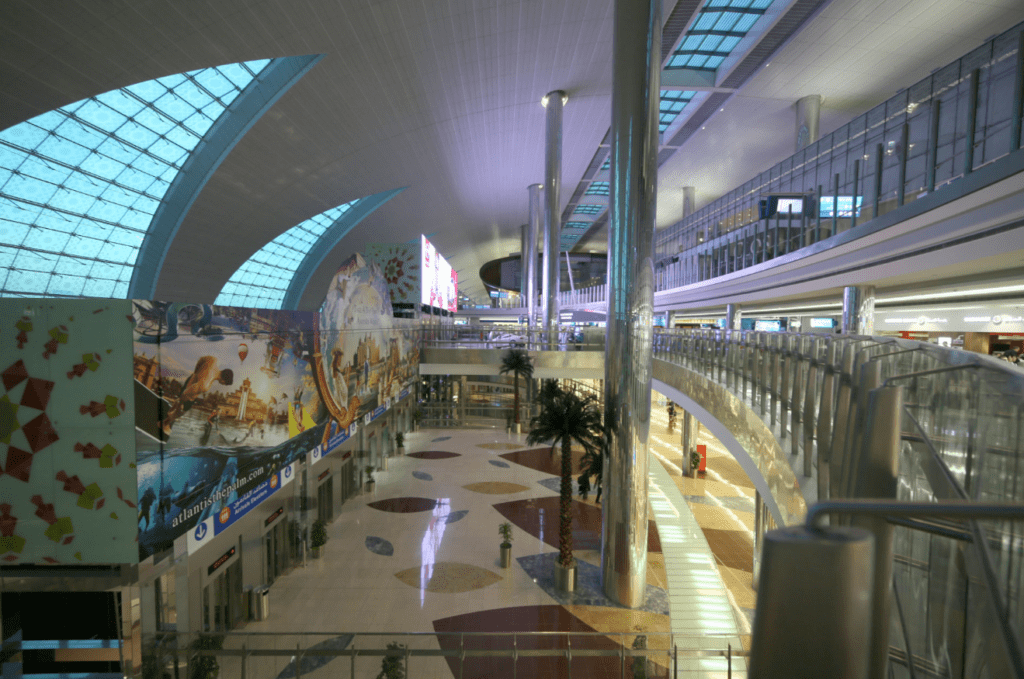
Source: Skatebiker
Air traffic
Main airlines based at DXB
Emirates operations at Dubai International
- Emirates Airline is the largest airline operating at the airport, with an all-wide-body fleet of over 200 Airbus and Boeing aircraft based at Dubai, providing scheduled services to the Middle East, Africa, Asia, Europe, North America, South America, Australia and New Zealand. It operates out of Terminal 3, Concourses A, B and C.
- Emirates SkyCargo, a subsidiary of Emirates, operates scheduled all-cargo services between Dubai and the rest of the world.
- Flydubai, a low-cost airline planning to operate over 100 aircraft on scheduled passenger services to and from Dubai, to the Middle East, Africa, Europe and South Asia. It operates from Terminal 2 and, since December 2018, also from Terminal 3 for selected destinations.
Recreational flying to Dubai is catered for by the Dubai Aviation Club, which undertakes flying training for private pilots and provides facilities for private owners.
The Government of Dubai provides short and long range search and rescue services, police support, medical evacuation and general purpose flights for the airport and all VIP flights to the airport.
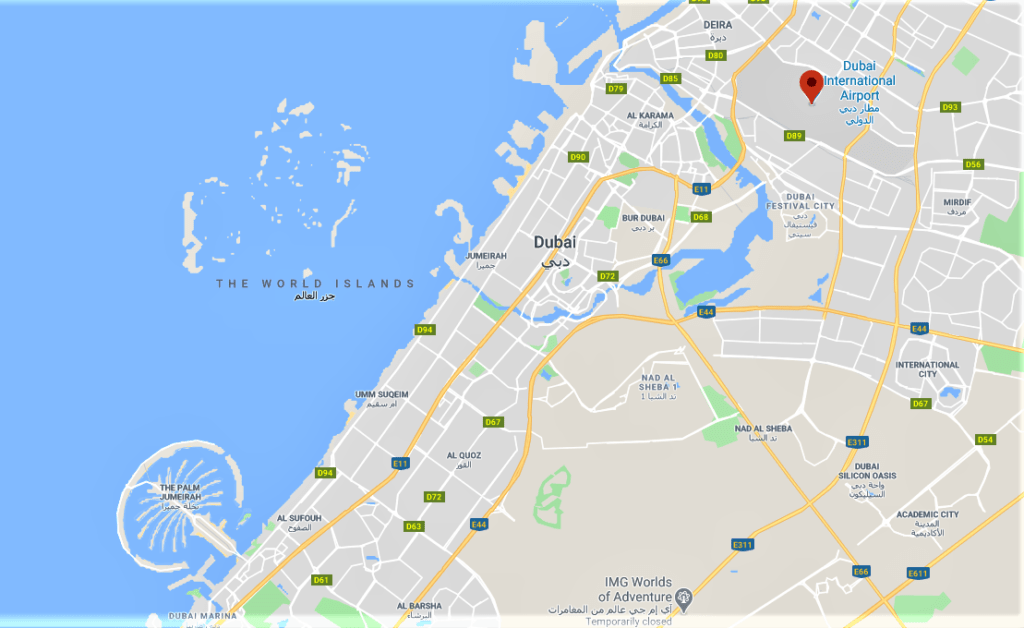
Control tower
The 87-metre-tall (285 ft) airport traffic control tower (ATCT) was constructed as part of phase two of the then -development plan.
Terminals
Dubai International Airport has three terminals. Terminal 1 has one concourse (concourse D), Terminal 2 is set apart from the other two main buildings and Terminal 3 is divided into Concourse A, B, and C. The cargo terminal is capable of handling 3 a million tonnes of cargo annually and a general aviation terminal (GAT) is close by.
Passenger terminals
Dubai Airport has three passenger terminals. Terminals 1 and 3 are directly connected with a common transit area, with airside passengers being able to move freely between the terminals without going through immigration, while Terminal 2 is on the opposite side of the airport. For transiting passengers, a shuttle service runs between the terminals, with a journey time of around 20 minutes from Terminal 2 to Terminal 1 and 30 minutes to Terminal 3. Passengers in Terminal 3 who need to transfer between concourse A and the rest of the Terminal have to travel via an automated people mover. Also after early 2016 when the construction of Concourse D was done, there is now an automated people mover between concourse D and Terminal 1.
Situated beside Terminal 2 is the Executive Flights Terminal, which has its own check-in facilities for premium passengers and where transportation to aircraft in any of the other terminals is by personal buggy.
The three passenger terminals have a total handling capacity of around 80 million passengers a year.
Terminals 1 and 3 cater to international passengers, whilst Terminal 2 is for budget passengers and passengers flying to the subcontinent and Persian Gulf region; Terminals 1 and 3 handle 85% of the passenger traffic and the Executive Flights terminal is for the higher-end travelers and important guests.
Terminal 1
Terminal 1 has a capacity of 15 million passengers. It is used by over 100 airlines and is connected to Concourse D by an automated people mover. It is spread over an area of 520,000 m2 (5,600,000 sq ft) and offers 221 check-in counters.
The Terminal was originally built to handle 18 million passengers; however, with extreme congestion at the terminal, the airport was forced to expand the terminal to accommodate the opening of 28 remote gates. Over the years, more mobile gates were added to the airport bringing the total as of 2010 to 28.
In 2013, Dubai Airports announced a major renovation for Terminal 1 and Concourse C. The renovations include upgraded baggage systems, replacement of check-in desks and a more spacious departure hall. Arrivals will also see improvements to help reduce waiting times. The renovation was completed by the middle of 2015.
Concourse D
Planning begun for further expansion of Dubai Airport, with the construction of Terminal 4, it was revealed on the day Emirates completed its phased operations at the new Terminal 3, on 14 November 2008. According to Dubai Airport officials, plans for Terminal 4 had begun and extensions would be made to Terminal 3. These are required to bring the capacity of the airport to 80–90 million passengers a year by 2015.
In May 2011, Paul Griffiths, chief executive of Dubai Airports revealed the Dubai Airport masterplan. It involves the construction of Concourse D (previously Terminal 4). With a capacity of 15 million, it would bring the total capacity of the airport to 90 million passengers by 2018—an increase of 15 million. It also will see Emirates take over the operation at Concourse C, along with concourse A and B which it will already be operating. All remaining airlines will shift to Concourse D, or move to Al Maktoum International Airport. The airport projects that international passenger and cargo traffic will increase at an average annual growth rate of 7.2% and 6.7%, respectively, and that by 2020 passenger numbers at Dubai International Airport will reach 98.5 million and cargo volumes will top 4.1 million tonnes.
Concourse D will have a capacity of 15 million passengers, include 17 gates and will be connected to Terminal 1 via an automated people mover. On 6 February 2016, members of the public were invited to trial the concourse in preparation for its opening. On Wednesday, 24 February 2016, Concourse D officially opened with the first British Airways flight arriving at gate D8.
Terminal 2
Terminal 2 built in 1998 has an area of 47,000 m2 (510,000 sq ft) and has a capacity of 10 million as of 2013, after several, decent reconstructions and a major expansion in 2012 which saw capacity double. It is used by over 50 airlines, mainly operating in the Persian Gulf region. Most flights operate to India, Saudi Arabia, Iran, Afghanistan and Pakistan.
In June 2009, Terminal 2 became the hub of Air India Express and flydubai, and the terminal houses the airline’s corporate head office.
Terminal 2 has undergone a major refurbishment recently, extending check-in and boarding facilities, changing the interior and exterior décor, and offering more dining choices to passengers. Capacity was increased to allow for 10 million passengers, an increase of 5 million.
The terminal has now increased the number of facilities available to passengers. Check-in counters have increased to 37. The boarding area is more spacious, with more natural light. Also the new open boarding gates allow several flights to board simultaneously, improving passenger and aircraft movements. There are a total of 43 remote stands at the terminal. However, passengers cannot move between Terminal 2 to 1 or from 2 to 3 and vice versa inside the airport. They have to make use of Taxi service or public transport available outside.
The Dubai duty-free shopping area covers 2,400 m2 (26,000 sq ft) in departures and 540 m2 (5,800 sq ft) in arrivals. The 3,600-square-metre (39,000 sq ft) extension included a larger arrivals hall as well.
Terminal 3
The partly underground Terminal 3 was built at a cost of US$4.5 billion, exclusively for Emirates and has a capacity of 65 million passengers. The terminal has 20 Airbus A380 gates at Concourse A and 5 at Concourse B and 2 at Concourse C. It was announced on 6 September 2012 that Terminal 3 would no longer be Emirates-exclusive, as Emirates and Qantas had set up an extensive code sharing agreement. Qantas would be the second and only one of two airlines to fly in and out of Terminal 3. This deal also allows Qantas to use the A380 dedicated concourse.
Upon completion, Terminal 3 was the largest building in the world by floor space, with over 1,713,000 m2 (18,440,000 sq ft) of space, capable of handling 60 million passengers in a year. A large part is located under the taxiway area and is directly connected to Concourse B: the departure and arrival halls in the new structure are 10 m (33 ft) beneath the airport’s apron. Concourse A is connected to the terminal via a Terminal 3 APM. It has been operational since 14 October 2008, and opened in four phases to avoid collapse of baggage handling and other IT systems.
The building includes a multi level underground structure, first and business class lounges, restaurants, 180 check-in counters and 2,600 car-parking spaces. The terminal offers more than double the previous retail area of concourse C, by adding about 4,800 m2 (52,000 sq ft) and Concourse B’s 10,700 m2 (115,000 sq ft) of shopping facilities.
In arrivals, the terminal contains 72 immigration counters and 14 baggage carousels. The baggage handling system—the largest system and also the deepest in the world—has a capacity to handle 8,000 bags per hour. The system includes 21 screening injection points, 49 make-up carousels, 90 km (56 mi) of conveyor belts capable of handling 15,000 items per hour at a speed of 27 km/h (17 mph) and 4,500 early baggage storage positions.
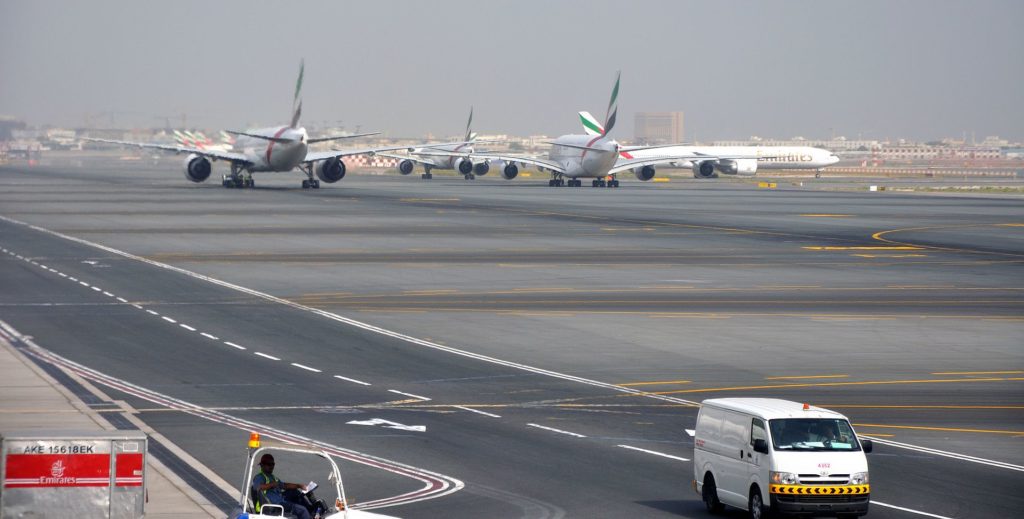
Source: Simisa
Concourse A
Concourse A, part of Terminal 3, opened 2 January 2013, has a capacity of 19 million passengers and is connected to the two major public levels of Terminal 3 via Terminal 3 APM in addition to the vehicular and baggage handling system utility tunnels for further transfer. The concourse opened on 2 January 2013 and was built at a cost of US$3.3 billion. The building, which follows the characteristic shape of Concourse B, 924 m (3,031 ft) long, 91 m (299 ft) wide and 40 m (130 ft) high in the centre from the apron level and accommodates 20 air bridge gates, of which all are capable of handling the Airbus A380-800. There are also 6 remote lounges for passengers departing on flights parked at 13 remote stands. The gates in concourse A are labelled A1–A24.
The concourse includes one 4-star hotel and one 5-star hotel, first- and business-class lounges, and duty-free areas. The total built-up area is 540,000 m2 (5,800,000 sq ft). The concourse allows for multi-level boarding and boasts the largest first and business class lounges in the world. Each lounge has its own dedicated floor offering direct aircraft access from the lounges. The total amount of retail space at the concourse is 11,000 m2 (120,000 sq ft), and there is also a total of 14 cafes and restaurants.
The total retail area in the concourse is approximately 11,000 m2 (120,000 sq ft).
Concourse B
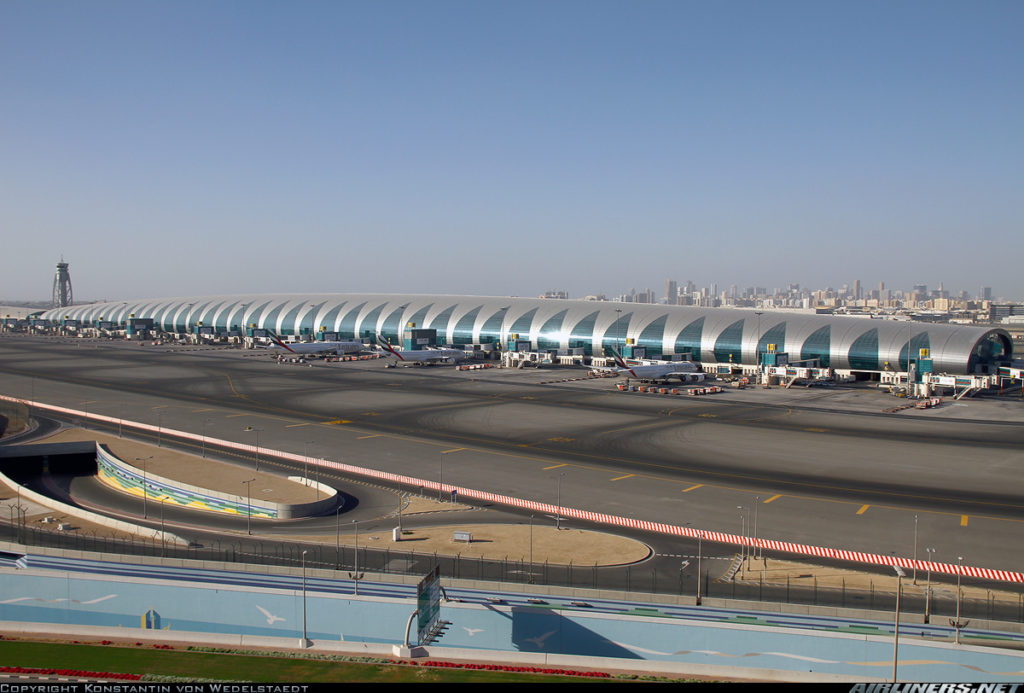
Source: AIRLINERS.NET
Concourse B is directly connected to terminal 3 and is dedicated exclusively to Emirates. The total built up area of the concourse itself is 675,000 m2 (7,270,000 sq ft). The concourse is 945 m (3,100 ft) long, 90.8 m (298 ft) wide (at midpoint) and 49.5 m (162 ft) high. The terminal has 10 floors (4 basements, a ground floor and 5 above floors). The building currently includes a multi-level structure for departures and arrivals and includes 32 gates, labelled B1–B32. The concourse has 26 air bridge gates and 5 boarding lounges for 14 remote stands that are for Airbus A340 and Boeing 777 aircraft only. For transit passengers the concourse has 3 transfer areas and 62 transfer desks.
The concourse also includes the Emirates first and Business class lounges, and the Marhaba lounge. The First class lounge has a capacity of 1,800 passengers and a total area of 12,600 m2 (136,000 sq ft). The Business class lounge has a capacity of 3,000 passengers and a total area of 13,500 m2 (145,000 sq ft). The Marhaba lounge, the smallest lounge at the concourse has a capacity of 300 passengers at a time.
The total retail area at the concourse is 120,000 m2 (1,300,000 sq ft), which also includes 18 restaurants within the food court. There are also three hotels in the concourse; a 5-star hotel and a 4-star hotel.
There is a direct connection to Sheikh Rashid Terminal (Concourse C) located at the control tower structure through passenger walkways. There is also a 300-room hotel and health club including both five and four star rooms. Concourse B includes five aerobridges that are capable of handling the new Airbus A380. Emirates Airline continues to maintain a presence in Concourse C, operating 12 gates at the concourse as well as the Emirates First Class and Business Class Lounges.
Concourse C
Concourse C, is a part of Terminal 3, was opened in 2000 and used to be the largest concourse at Dubai International Airport before Concourse B in Terminal 3 opened. It incorporates 50 gates, including 28 air bridges and 22 remote gates located at a lower level of the terminal. The gates are labelled C1–C50.
The concourse includes over 17 food and beverage cafes and restaurants, with the food court being located on the Departures Level. Also located in the concourse is a 5-star hotel and a 5,400 m2 (58,000 sq ft) duty-free shopping facility. Other facilities include prayer rooms and a medical centre. Concourse C became part of Terminal 3 in 2016 after concourse D opened.
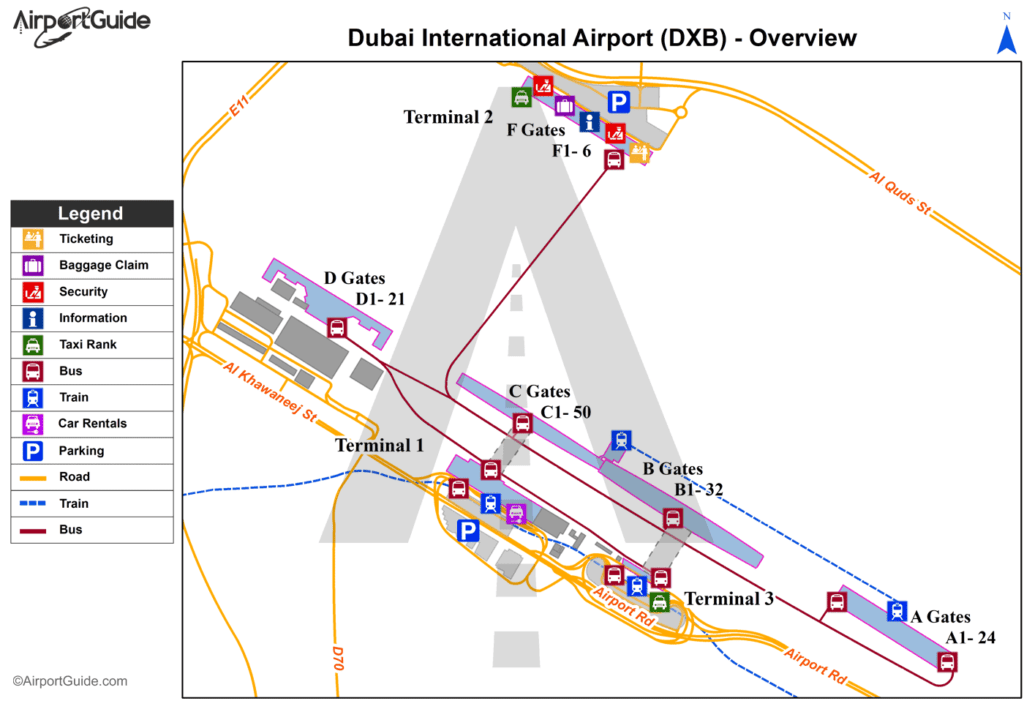
Al Majlis VIP Pavilion and Dubai Executive Flight Terminal
The Al Majlis VIP pavilion was exclusively built for the Dubai Royal Air Wing and opened on 1 July 2008. The entire facility is a 3,400-square-metre (37,000 sq ft) terminal, and includes a Royal Majlis and an antenna farm. It also includes eight aircraft hangars with a total built up area of 69,598 m2 (749,150 sq ft) and maintenance hangars for Boeing 747s and Airbus A380s, and a 1,200-square-metre (13,000 sq ft) gatehouse for VIP service. In 2010 there were 47,213 customers, 13,162 movements and in 2009, there were a total of 43,968 customers and 14,896 movements.
Executive Flight Services (EFS) caters to those passengers of high class or special importance that travel through Dubai International Airports. It is the largest dedicated business aviation terminal of its kind in the Middle East. It is located at the Dubai Airport Free Zone close to Dubai International’s Terminal 2. It only caters to private flights exclusive to the terminal. Airlines operating from the terminal are expected to maintain a lounge. In 2010, EFS handled 7,889 aircraft movements and 25,177 passengers.
The centre itself is located close to Terminal 2, and includes a 5,500 m2 (59,000 sq ft) two-storey main building, a 3,700 m2 (40,000 sq ft) hangar, a 3,700 m2 (40,000 sq ft) ramp area for aircraft parking and a special VIP car park for long term parking. The centre also has its own immigration and customs sections, its own Dubai Duty Free outlet, a fully equipped business and conference centre, eight luxury private lounges and a limousine service between aircraft and the terminal.[citation needed] The ramp area of the terminal can accommodate up to 22 small-sized private jets, between 8 and 12 medium-sized jets or up to four large-sized jets such as a Boeing Business Jet (BBJ), the Boeing 727 or the Airbus A319. The facility makes EFC the largest dedicated business aviation terminal in the Middle East.

Cargo Mega Terminal
The cargo village at Dubai International Airport is one of the world’s largest and most central cargo hubs, with most of the cargo for Asia and Africa coming through the facility. Forecasts in 2004 for cargo growth predicted that additional major cargo handling facilities were needed to satisfy demands. Plans were put in place to construct the first stage of the cargo mega terminal, which by 2018 will have the ability to handle three million tons of freight. Phase 1 of the cargo mega terminal was completed by 2004 and the next phase of expansion was scheduled for completion in late 2007. Presently the airport has a cargo capacity of 2.5 million tonnes, and will be expanded to handle 3 million.
Flower centre
Dubai airport has constructed a flower centre to handle flower imports and exports, as Dubai is a major hub for the import and export of flowers and the airport required a specialist facility since these products need special conditions. The flower centre’s first phase was completed in 2004 at a cost of $50 million.
The centre when completed and functioning will have a floor area of approximately 100,000 m2 (1,100,000 sq ft) including different export chambers and offices. The handling capacity of the centre is expected to be more than 300,000 tonnes of product throughput per annum. The entire facility (with the exception of the offices) will be maintained at an ambient temperature of just 2 to 4 °C (36 to 39 °F).
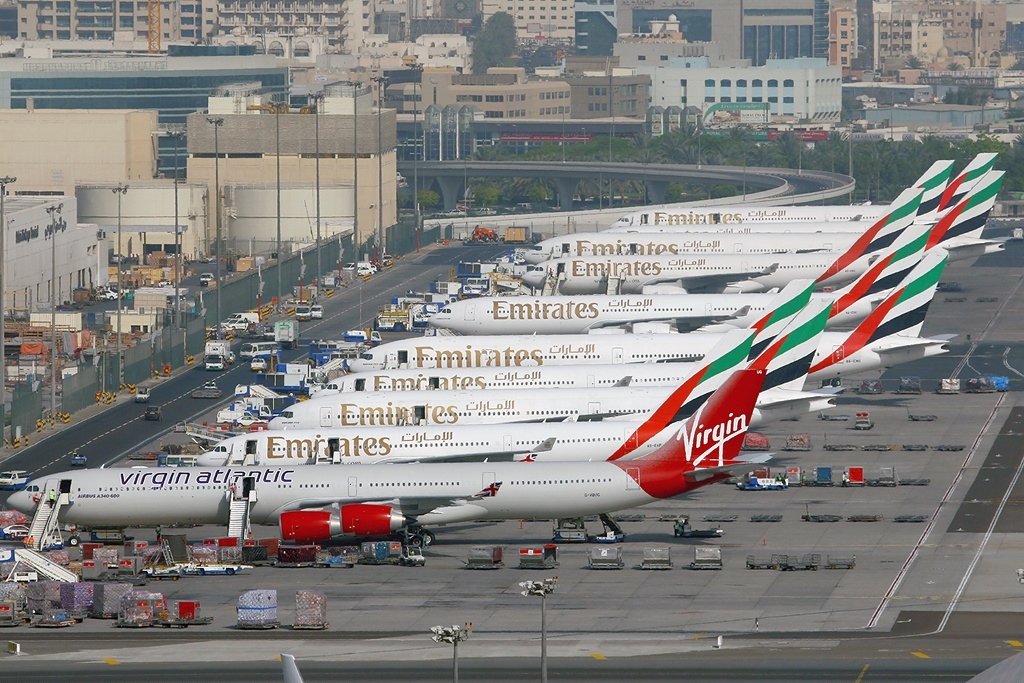
Source: http://www.airliners.net/photo/Virgin-Atlantic-Airways/Airbus-A340-642X/1204296/L
Runways
Dubai Airport has two closely spaced parallel runways, 12R/30L is 4,000 m × 60 m (13,120 ft × 200 ft), 12L/30R is 4,000 m × 60 m (13,120 ft × 200 ft). The gap between the centrelines of the two runways is 385 m (1,263 ft). The runways are equipped with four sets of ILS to guide landing aircraft safely under very poor weather conditions. The runways were expanded to accommodate the Airbus A380 which came into service in 2007. In 2009, it was announced that the airport installed a Category III landing system, allowing planes to land in low-visibility conditions, such as fog. This system will be the first of its kind in the United Arab Emirates.
In 2013 Dubai Airports announced an 80-day runway refurbishment program which started on 1 May 2014 and was completed on 21 July 2014. The northern runway was resurfaced while lighting upgrades and additional taxiways were built on the southern runway to help boost its capacity. The southern runway was closed from 1 to 31 May 2014, while the northern runway was closed from 31 May to 20 July 2014. Due to extra congestion on one runway, all freighter, charter and general aviation flights were diverted to Al Maktoum International Airport. Flights at DXB were reduced by 26% and 14 airlines moved to Al Maktoum International Airport whilst the runways works were being done. Emirates cut 5,000 flights and grounded over 20 aircraft during the period.
Dubai Airports plans to close the southern runway (12R/30L) for complete resurfacing and replacement of the airfield lighting and supporting infrastructure. This will be done during a 45-day period from 16 April 2019 to 30 May 2019. This upgrade will boost safety, service and capacity levels at DXB. Airlines will be required to reduce flight operations at DXB due to single runway operations.
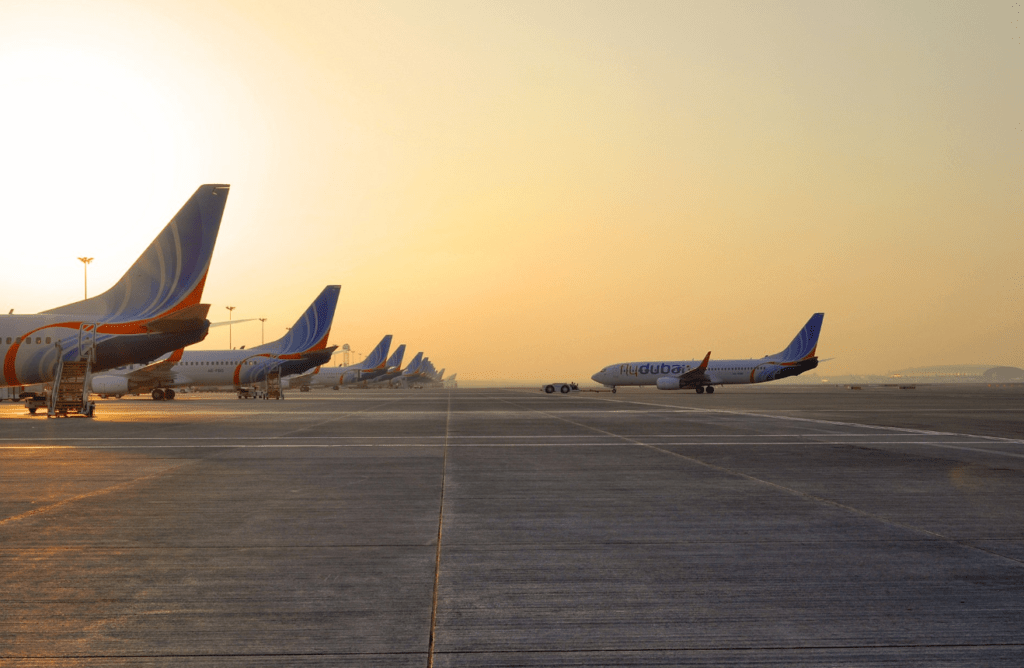
Source: DXB/OMDB Terminal 2 Ramp
Airlines and destinations
Passenger
| Aeroflot | Moscow–Sheremetyevo |
| African Express Airways | Berbera, Hargeisa, Mogadishu, Nairobi–Jomo Kenyatta, Wajir |
| Air Algérie | Algiers |
| Air Astana | Almaty, Nur-Sultan |
| Airblue | Islamabad, Lahore, Multan, Peshawar |
| Air Canada | Toronto–Pearson |
| Air China | Beijing–Capital, Chongqing |
| Air France | Paris–Charles de Gaulle |
| Air India | Bangalore, Chennai, Delhi, Goa, Hyderabad, Indore, Kochi, Kolkata, Kozhikode, Mumbai, Visakhapatnam |
| Air India Express | Amritsar, Delhi, Jaipur, Kochi, Kozhikode, Lucknow, Mangalore, Mumbai, Pune, Thiruvananthapuram, Tiruchirappalli |
| AnadoluJet | Istanbul–Sabiha Gökçen |
| Ariana Afghan Airlines | Kabul, Kandahar |
| Azur Air | Moscow–Vnukovo |
| Azur Air Ukraine | Seasonal charter: Kiev–Boryspil |
| Azerbaijan Airlines | Baku |
| Badr Airlines | Khartoum |
| Biman Bangladesh Airlines | Chittagong, Dhaka |
| British Airways | London–Heathrow |
| Cathay Pacific | Bahrain, Hong Kong |
| Cebu Pacific | Manila |
| China Eastern Airlines | Kunming, Qingdao, Shanghai–Pudong, Xi’an |
| China Southern Airlines | Guangzhou, Lanzhou, Shenzhen, Ürümqi, Wuhan |
| Daallo Airlines | Hargeisa, Mogadishu |
| Druk Air | Delhi, Paro (both begin 4 September 2020) |
| EgyptAir | Cairo |
| Emirates | Abidjan, Abuja, Accra, Addis Ababa, Adelaide, Ahmedabad, Algiers, Amman–Queen Alia, Amsterdam, Athens, Auckland, Baghdad, Bahrain, Bangalore, Bangkok–Suvarnabhumi, Barcelona, Basra, Beijing–Capital, Beirut, Birmingham, Bologna, Boston, Brisbane, Brussels, Budapest, Buenos Aires–Ezeiza, Cairo, Cape Town, Casablanca, Cebu, Chennai, Chicago–O’Hare, Christchurch, Clark, Colombo–Bandaranaike, Conakry, Copenhagen, Dakar–Diass, Dallas/Fort Worth, Dammam, Dar es Salaam, Delhi, Denpasar/Bali, Dhaka, Dublin, Durban, Düsseldorf, Edinburgh, Entebbe, Erbil, Fort Lauderdale, Frankfurt, Geneva, Glasgow, Guangzhou, Hamburg, Hanoi, Harare, Ho Chi Minh City, Hong Kong, Houston–Intercontinental, Hyderabad, Islamabad, Istanbul, Istanbul–Sabiha Gökçen, Jakarta–Soekarno-Hatta, Jeddah, Johannesburg–O. R. Tambo, Kabul, Karachi, Khartoum, Kochi, Kolkata, Kozhikode (Suspended Temporary), Kuala Lumpur–International, Kuwait, Lagos, Lahore, Larnaca, Lisbon, London–Gatwick, London–Heathrow, London–Stansted, Los Angeles, Luanda, Lusaka, Lyon, Madrid, Mahé, Malé, Malta, Manchester, Manila, Mauritius, Medina, Melbourne, Mexico City, Milan–Malpensa, Moscow–Domodedovo, Mumbai, Munich, Muscat, Nairobi–Jomo Kenyatta, Newark, Newcastle upon Tyne, New York–JFK, Nice, Orlando, Osaka–Kansai, Oslo–Gardermoen, Paris–Charles de Gaulle, Penang (begins 1 May 2020), Perth, Peshawar, Phnom Penh, Phuket, Porto, Prague, Rio de Janeiro–Galeão, Riyadh, Rome–Fiumicino, Saint Petersburg, San Francisco, Santiago de Chile, São Paulo–Guarulhos, Seattle/Tacoma, Seoul–Incheon, Shanghai–Pudong, Sialkot, Singapore, Surabaya, Stockholm–Arlanda, Sydney, Taipei–Taoyuan, Tehran–Imam Khomeini, Thiruvananthapuram, Tokyo–Haneda, Tokyo–Narita, Toronto–Pearson, Tunis, Venice, Vienna, Warsaw–Chopin, Washington–Dulles, Zurich Seasonal: Zagreb |
| Ethiopian Airlines | Addis Ababa |
| Finnair | Seasonal: Helsinki |
| flydubai | Abha, Addis Ababa, Ahmedabad, Ahvaz, Alexandria–Borg el Arab, Al Jawf, Almaty, Amman–Queen Alia, Ashgabat, Asmara, Baghdad, Bahrain, Baku, Basra, Beirut, Belgrade, Bishkek, Bratislava, Bucharest, Catania, Chennai, Chittagong, Colombo–Bandaranaike, Dammam, Dar es Salaam, Delhi, Djibouti, Dushanbe, Entebbe, Erbil, Faisalabad, Gassim, Ha’il, Hargeisa, Helsinki, Hofuf, Hyderabad, Isfahan, Istanbul–Sabiha Gökçen, Jizan, Jeddah, Juba, Kabul, Karachi, Kathmandu, Khartoum, Kiev–Boryspil, Kilimanjaro, Kochi, Kozhikode, Krabi, Kraków, Krasnodar, Kuwait, Lar, Lucknow, Mashhad, Medina, Moscow–Vnukovo, Multan, Mumbai, Muscat, Najaf, Naples, Nur-Sultan, Odessa, Port Sudan, Prague, Quetta, Riyadh, Salalah, Sarajevo, Shiraz, Shymkent, Sialkot, Skopje, Sochi, Sofia, Sulaimaniyah, Tabuk, Ta’if, Tashkent, Tbilisi, Tehran–Imam Khomeini, Yangon, Yekaterinburg, Yerevan, Zanzibar Seasonal: Batumi (resumes 26 May 2020), Dubrovnik, Kazan, Kutaisi, Makhachkala, Mineralnye Vody, Qabala, Rostov-on-Don, Samara, Tivat, Zagreb |
| Flynas | Dammam, Jeddah, Riyadh |
| GoAir | Kannur |
| Gryphon Airlines | Balad, Kandahar, Kuwait, Ras al Khaimah |
| Gulf Air | Bahrain |
| IndiGo | Ahmedabad, Amritsar, Bangalore, Chandigarh, Chennai, Delhi, Hyderabad, Kochi, Kolkata, Kozhikode, Mumbai, Thiruvananthapuram |
| Iran Air | Bandar Abbas, Isfahan, Qeshm Island, Shiraz, Tehran–Imam Khomeini |
| Iraqi Airways | Baghdad, Basra, Erbil, Najaf |
| Jazeera Airways | Kuwait |
| Jordan Aviation | Amman–Queen Alia |
| Jubba Airways | Bosaso, Hargeisa, Mogadishu |
| Kam Air | Kabul |
| Karun Airlines | Ahvaz |
| Kenya Airways | Nairobi–Jomo Kenyatta |
| Kish Air | Bandar Abbas, Kish Island, Shiraz |
| KLM | Amsterdam |
| Korean Air | Seoul–Incheon |
| Kuwait Airways | Kuwait |
| Lufthansa | Frankfurt |
| Mahan Air | Mashhad, Shiraz, Tehran–Imam Khomeini |
| Middle East Airlines | Beirut |
| Nepal Airlines | Kathmandu |
| Norwegian Air Shuttle | Seasonal: Copenhagen, Oslo–Gardermoen, Stockholm–Arlanda |
| Oman Air | Muscat, Salalah |
| Pakistan International Airlines | Faisalabad, Islamabad, Karachi, Lahore, Multan, Peshawar |
| Pegasus Airlines | Istanbul–Sabiha Gökçen |
| Philippine Airlines | Manila |
| Qeshm Airlines | Qeshm Island, Tehran–Imam Khomeini |
| Rossiya | Seasonal charter: Moscow–Vnukovo |
| Royal Brunei Airlines | Bandar Seri Begawan |
| Royal Jordanian | Amman–Queen Alia |
| RwandAir | Kigali, Mombasa |
| S7 Airlines | Seasonal: Novosibirsk |
| SalamAir | Muscat |
| Saudia | Dammam, Jeddah, Medina, Riyadh |
| SaudiGulf Airlines | Riyadh |
| Sichuan Airlines | Chengdu, Yinchuan |
| Singapore Airlines | Singapore |
| Smartwings | Ostrava, Prague |
| Somon Air | Dushanbe |
| SpiceJet | Ahmedabad, Amritsar, Delhi, Jaipur, Kochi, Kozhikode, Madurai, Mangalore, Mumbai, Pune |
| SriLankan Airlines | Colombo–Bandaranaike |
| Swiss International Air Lines | Muscat, Zurich |
| Syrian Air | Damascus |
| Thai Airways | Bangkok–Suvarnabhumi |
| Transavia | Seasonal: Amsterdam |
| Turkish Airlines | Istanbul |
| Turkmenistan Airlines | Ashgabat |
| Ukraine International Airlines | Kiev–Boryspil |
| Ural Airlines | Chelyabinsk, Yekaterinburg Seasonal: Moscow–Domodedovo, Samara |
| Vistara | Mumbai |
| Yamal Airlines | Seasonal: Tyumen |
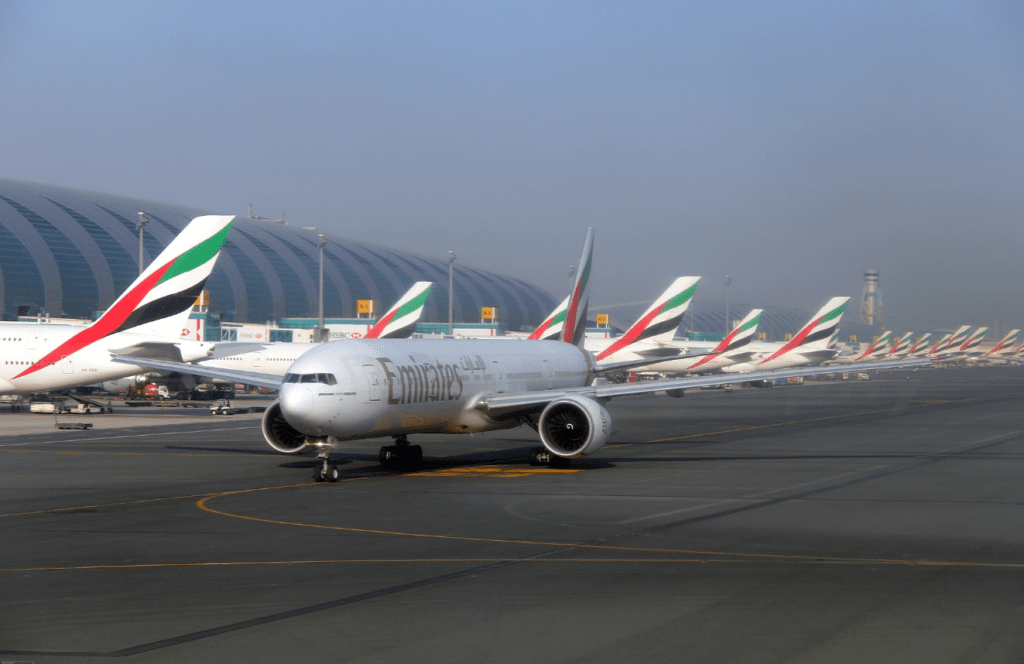
Source: Emirates – B777-31H(ER) – A6-EBM
Cargo
| SL Airlines Belgium | Delhi, Liege |
| Cargolux | Hong Kong, Komatsu, Luxembourg |
| Coyne Airways | Baghdad, Balad, Djibouti, Erbil, Kabul, Kandahar, Sana’a |
| Emirates SkyCargo | Adelaide, Leipzig/Halle |
| Ethiopian Airlines | Addis Ababa |
| FedEx Express | Athens, Bengaluru, Chengdu, Delhi, Goa, Hong Kong, Milan–Malpensa, Mumbai, Paris–Charles de Gaulle |
| FitsAir | Abu Dhabi, Baghdad, Balad, Colombo–Bandaranaike, Erbil, Herat, Jalalabad, Kabul, Kandahar, Lashkar Gah, Sharana, Sulaymaniyah, Tarin Kowt, Thumrait |
| Iran Air Cargo | Tehran–Imam Khomeini |
| Royal Airlines | Karachi |
| Royal Jordanian Cargo | Amman–Queen Alia |
| Silk Way Airlines | Baku |
| Spice Xpress | Nashik |
| TCS Couriers | Lahore, Karachi, Islamabad |
| UPS Airlines | Bangkok–Suvarnabhumi, Clark, Cologne/Bonn, Guangzhou, Hong Kong, Louisville, Delhi, Singapore, Sydney |
Ground transportation
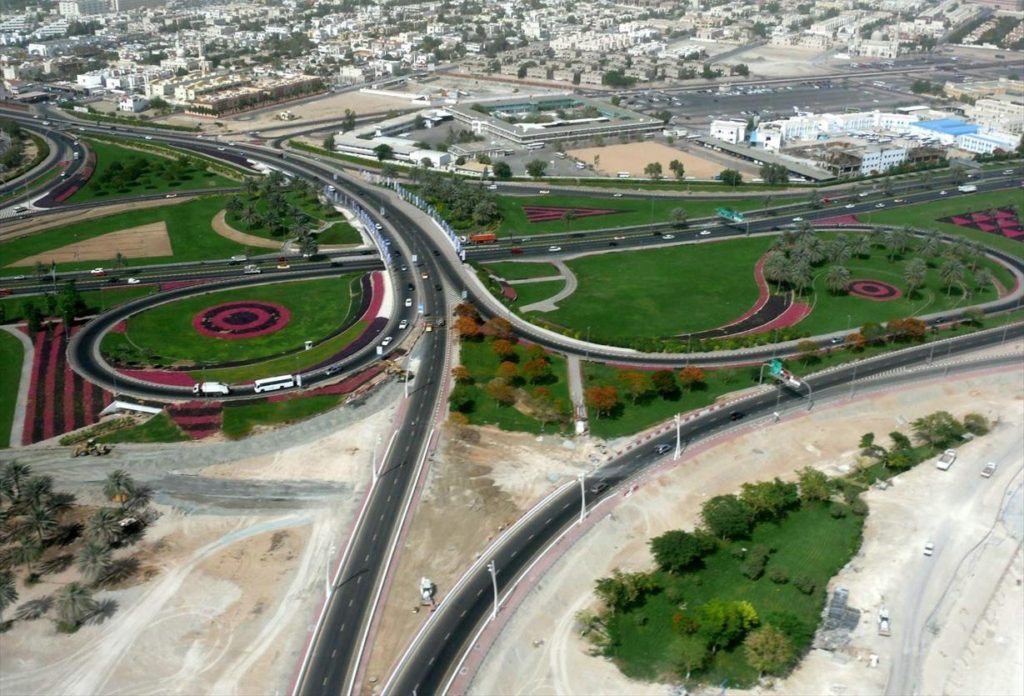
Source: Dubai Construction Update Part 11 Page 16
Road
The airport is connected by the road D 89. One of the longest intra-city roads, D 89 begins at the Deira Corniche and runs perpendicular to D 85 (Baniyas Road). From Deira, the road progresses south-eastward towards Dubai International Airport, intersecting with E 311 (Emirates Road) past the airport. A road tunnel underneath one of the runways, was built in 2003.
Metro
The airport is served by Dubai Metro, which operates two lines through or near the airport. The Red Line has a station at each of Terminal 3 and Terminal 1. Services run between 6 am and 11 pm every day except Friday, when they run between 1 pm and midnight. These timings differ during the Islamic holy month of Ramadan. The stations are located in front of both terminals and can be accessed directly from the arrivals areas.
The Green Line has at a station near the Airport Free Zone, from which passengers can connect to Terminal 2.
The Purple and Blue Lines are under construction and these two lines will also have a station.
Bus
Dubai Buses operated by RTA run a number of routes to the city but mainly Deira and are available at the Airport Ground Transportation centre and the Arrivals at every terminal.
Passengers who need to transfer between Terminals 1 and 3, and Terminal 2 can use the inter-terminal shuttle bus service which operates frequently.
Bus stations are situated opposite both Terminal 1, 2 and 3. Local buses 4, 11, 15, 33 and 44 can be used to connect with Terminal 1 and 3, while bus 2 connects with Terminal 2. Dubai International Airport Buses provide air-conditioned transport into the city centre and over 80 hotels in the city.
Emirates offers a complimentary coach service, which operates three daily services to and from Al Ain, and four daily, to and from Abu Dhabi. So does Eithad.
Taxi
The airport is served by the Government owned Dubai Taxi Agency, which provides 24-hour service at the arrivals in every terminal.
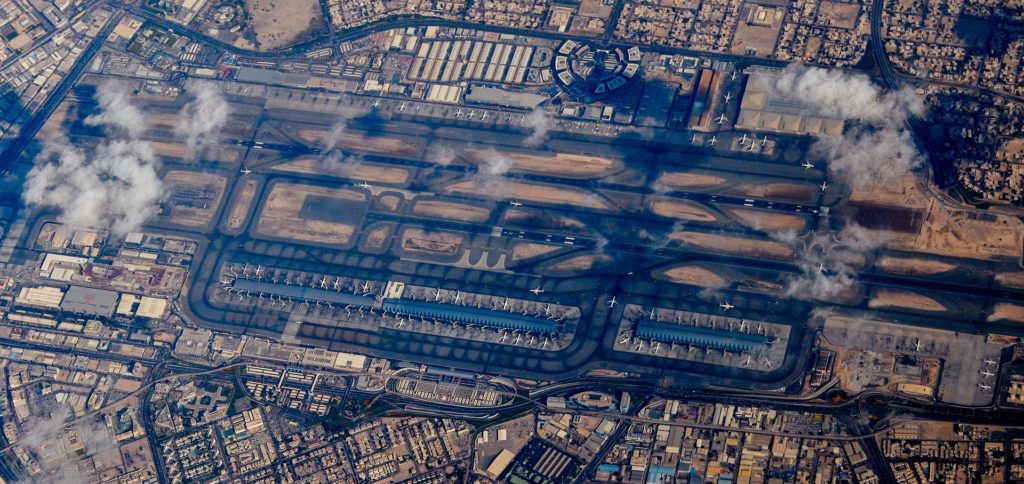
Source: Dubai Airport overview
Accidents and incidents
- On 14 March 1972, Sterling Airways Flight 296 crashed on approach to Dubai, killing 112.
- On 22 November 1974, British Airways Flight 870, a Vickers VC10, from Dubai to Heathrow, was hijacked in Dubai, landing at Tripoli for refuelling before flying on to Tunis. One hostage was murdered before the hijackers eventually surrendered after 84 hours. Captain Jim Futcher was awarded the Queen’s Gallantry Medal, the Guild of Air Pilots and Air Navigators Founders Medal, the British Air Line Pilots Association Gold Medal and a Certificate of Commendation from British Airways for his actions during the hijacking, having returned to the aircraft to fly it knowing the hijackers were on board.
- In 1999, Indian Airlines Flight IC814 was hijacked over Indian airspace and tried to land at Dubai, after being prevented from landing in neighboring Oman. The airport authorities made sure that the plane could not land by stationing airport equipment and coaches on the runways. The plane later landed at a UAE military base.
- On 12 March 2007, the nose gear of Biman Bangladesh Airlines Flight BG006, an Airbus A310-300, collapsed while the aircraft was accelerating down the runway. The plane was carrying 236 passengers and crew. Fourteen people suffered minor injuries in the accident. The aircraft came to rest at the end of the runway and was evacuated, but the accident crippled the only active runway and forced the airport to close for eight hours, affecting 71 flights.
- On 3 September 2010, UPS Flight 6, operating a Boeing 747-44AF N571UP crashed shortly after take-off, killing both crew and destroying the aircraft. N571UP was operating an international cargo flight to Cologne Bonn Airport, Germany.
- On 3 August 2016, Emirates Flight 521 from Trivandrum International Airport, operating a Boeing 777-300 A6-EMW crashed upon landing. All 300 passengers and crew evacuated safely. However, one airport firefighter died battling the flames.
Source: https://en.wikipedia.org/wiki/Dubai_International_Airport
